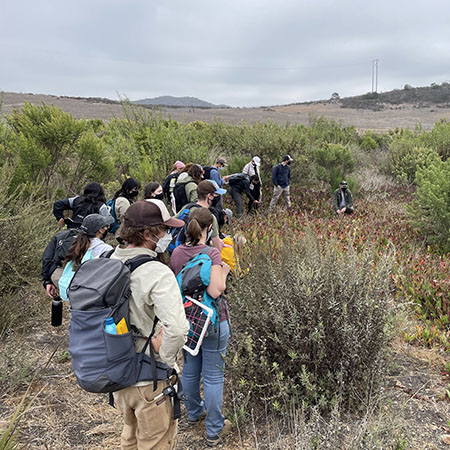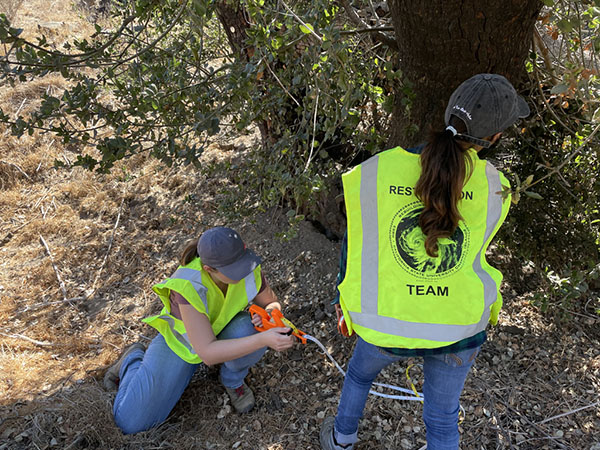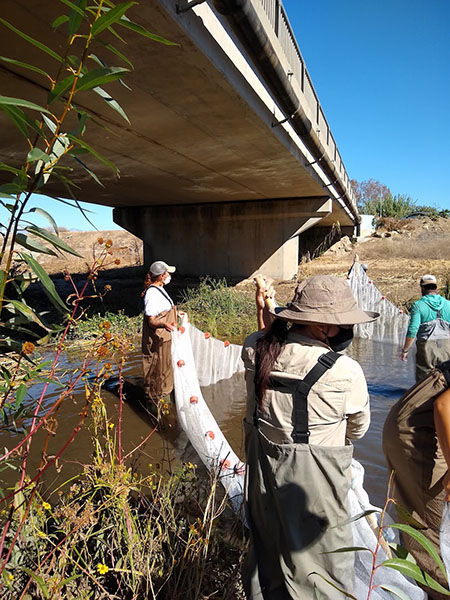 A CSU Channel Islands (CSUCI) conservation and research program launched in Fall of 2021 will continue and expand in Spring of 2022 for Environmental Science & Resource Management (ESRM) students.
A CSU Channel Islands (CSUCI) conservation and research program launched in Fall of 2021 will continue and expand in Spring of 2022 for Environmental Science & Resource Management (ESRM) students.
The field studies class is designed to give students experience conducting environmental and conservation research outdoors with tools and methods they will use as professionals in the field of environmental science.
Taught by Assistant Professor of ESRM Dan Reineman, Ph.D. and ESRM Lecturer
Brenton Spies, a Ph.D. candidate at UCLA, the field studies class was previously conducted in outdoor areas near the campus—and during the pandemic, in students’ own backyards. But since Fall of 2021, Reineman and Spies have broadened the scope of the class to local open spaces, including the Santa Monica Mountains and hills above Ventura.
“This class is really about teaching students how to go out into the field—into nature—and to see it as an environmental scientist would—to ask themselves ‘is this system healthy?’ and ‘why or why not?’ and then to measure its health, diversity, and human impacts,” Reineman said. “Our goal is always to teach in such a way that the students are not only learning these skills, but are gathering real data they can share back with landowners and community members who are interested.”
The first research trip in the Fall was to Rancho Sierra Vista/Satwiwa National Recreation Area, which is part of the National Park Service.
 “The Park is actively doing restoration and they reached out to us to help them assess pollinator abundance and diversity in newly restored coastal sage scrub,” Spies said. “They wanted to see how well native plants were attracting pollinators after they had removed and replaced the non-native, invasive plants.”
“The Park is actively doing restoration and they reached out to us to help them assess pollinator abundance and diversity in newly restored coastal sage scrub,” Spies said. “They wanted to see how well native plants were attracting pollinators after they had removed and replaced the non-native, invasive plants.”
Students used field equipment such as “transect tapes” and “quadrats,” which are simple tools to designate specific areas in which to compare measurements—in this case, counts of pollinators and the types of plants that attract them.
“One of the biggest discoveries the students made from their surveys is that the honeybees love one of the major plants used in the restoration—coyote brush,” Spies said. “There were thousands and thousands of honeybees pollinating the coyote brush!”
Reineman and Spies also partnered with Ventura Land Trust so students were able to do research in Harmon Canyon, which the Land Trust recently acquired. There are thousands of oak trees on the property and the Land Trust wants to be a good steward to the land.
“They asked us to assess the oak population by measuring their health with indicators like size, leaf density, and acorn abundance,” Spies said. “We trained the students to do tree demographic surveys, which is a common skill these students might need when applying to any number of environmental science jobs. Then we spent a whole day surveying trees… but it will take us a few generations of students to get through the whole preserve.”

Reineman and Spies plan to build the program to include other agencies and entities, such as the U.S. Fish & Wildlife Service, Western Foundation of Vertebrate Zoology in Camarillo, or Ojai Valley Land Conservancy.
“The abilities of our students and the services this class can provide are becoming popular with our local partners now,” Spies said. So we’re getting lots of project proposals and are excited to continue growing the course and our collaboration.”
In Spring, Spies and Reineman hope to add Spies’ research specialty to the field studies class—the endangered Tidewater Goby. The fish is about two inches long and can survive in closed coastal lagoons. The fish is foundational in the food chain, so it serves as a kind of canary in a coal mine, and can tell us a lot about the health of a water system.
One of the necessities of being a good field researcher is being prepared, Spies said, which is why Reineman and Spies teach the students some fundamental field preparedness skills, including basic car mechanics skills.
“When you do field work, you have to take your car on long adventures, so we take students to the campus mechanics shop and teach them how to change a tire and about the oil and battery,” Spies said. “We do a scavenger hunt at Home Depot.”
